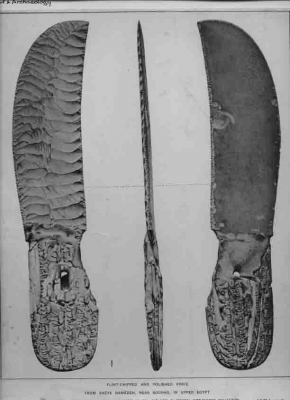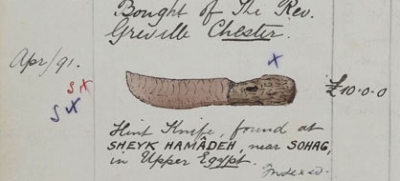To search the RPR site click here
The Pitt Rivers Egyptian flint knife
Alice Stevenson, Pitt Rivers Museum
In April 1891 General Pitt-Rivers purchased from the Reverend Greville Chester an ancient Egyptian flint knife set in a decorated ivory handle for 10 pounds. [Add.9455vol2_p727 /2] Chester (1830–1892) regularly wintered abroad in Egypt where he purchased material for the British Museum, the Ashmolean and the Fitzwilliam Museum. He also sought buyers for his other acquisitions and regularly offered material to Pitt-Rivers, as his letters in the Salisbury and Wiltshire Museum demonstrate. [1] Of the pieces the General purchased from Chester the flint knife is undoubtedly not only one of the finest pieces, but also one of the most famous ancient Egyptian objects ever to have been in Pitt-Rivers’s collection.
“...the finest examples of such work that are known from any country or age” (Petrie 1896, 50)
The caramel-coloured flint portion of the Pitt-Rivers knife is distinctive and is of a type known in the literature as a ‘ripple-flaked knife’. At the time of the knife’s purchase its date was unknown, but in 1894 the pioneering archaeologist W.M.F. Petrie came across identical examples of unhafted flint implements in situ amongst the grave assemblages of a vast cemetery at Naqada. Petrie and Pitt-Rivers had been acquainted since at least 1877, when Petrie is known to have presented his research on British earthworks to the Royal Archaeological Institute (see Drower 1985, 25). The two men subsequently had a chance encounter in the shadow of the Great Pyramid in February 1881 (Burleigh and Clutton Brock 1982) and were certainly in correspondence until the General's death in 1900. Pitt-Rivers sent Petrie a drawing of his knife in 1895, [2] which Petrie then included in his excavation report on Naqada alongside the knives he had discovered. Such knives, along with distinctive pottery and other grave goods were so unusual, so ‘wholly un-Egyptian’ (Petrie 1896, 8), in comparison to what was then known that Petrie believed that they belonged to a ‘New Race’ who had invaded Egypt at the end of the Old Kingdom. It was Petrie’s rival, the Frenchman Jacques De Morgan, who argued that these remains did in fact belong to prehistoric times. Petrie, although dismissive of de Morgan’s scholarship and field practices, accepted this and he set about using the assemblages he discovered at Naqada to give a sequential structure to this newly identified prehistoric era. The period became known as the Predynastic (c. 4500 BC – 3100 BC) and it saw the rise of social complexity in the Egyptian Nile Valley, which culminated in the emergence of one of the world’s first territorial states.
The chronological framework Petrie created for Predynastic Egypt using pottery remains broadly correct today and the sequence is now generally referred to using phases named after the site of Naqada. Within this sequence ripple-flaked knives appear in graves corresponding to phase Naqada IIC/D (roughly 3600 to 3350 BC); they are often considered to be one of the ‘signature’ artefacts of this part of the Predynastic period.
Many of ripple-flake knives found in graves show little evidence of wear on the edges. Some, however, were ritually ‘killed’ during funerals and laid carefully in burials in two halves, such the example from Gerzeh grave 25, now in the Pitt Rivers Museum (1911.33.1). Those that were not treated in this way may have been in circulation for several generations, with some being later reworked to accommodate decorated handles. Dating those with handles is more difficult as most of the known examples were purchased on the art-market (see below), as indeed the Pitt-Rivers knife was originally. All that is known is that Chester had bought the knife from a dealer who reported its find spot to be Sheikh Hamada, near Sohag in Upper Egypt. Recently excavated pieces, however, provide possible dates around 3300 BC. Dates around 3100 BC are also likely and some may even have been accessible within temples of the Old Kingdom (Wengrow 2006, 176).
“The artistic and technical masterpieces of Man's work in flaking stone” (Knowles 1953, 105)
As noted by PRM researcher Francis Knowles, ripple-flaked flints embody great skill and labour (Kelterborn 1984; Midant-Reynes 1987). They are characterized by fine, regular, parallel fluting retouch upon one face and a smooth ground surface on the other. They were made by applying pressure to a localized area to remove small pieces of flint, thereby giving a rippled effect, rather than striking the flint with another implement. The curved edge was finely serrated and the base and distal ends were also retouched. Regardless of where they are found all are virtually identical in style. This has led flint analysts to argue that they may have been produced by a group of workshops in one area and may be the product of a few craftsmen who practised this extremely specialized skill over a period of a few generations (Holmes 1989, 338). The butts of such knives are broad and those examples with handles had to be chipped down to a narrow wedge in order to fit into their ivory holds. This suggests that the flints were only later adapted, possibly some time after their production. The aesthetic appeal of these knives emanates not only from their impressive workmanship, but also from the care taken in the selection of raw material on which they were made. Flint is widely available along the Nile between Cairo and Esna within the limestone outcrops, but caramel-golden coloured pieces were preferentially selected for the most specialist knapping (Holmes 1992, 39), perhaps because they resembled the colour of metals.
The ivory handle of the Pitt-Rivers knife itself is badly damaged, but six rows of animals depicted marching towards the flint portion of the knife with their heads held high can be seen. On the face without the boss are figures carved in relief of elephants on serpents, storks, a possible heron, lions followed by a dog, short and long-horned cattle, and what may be jackals. On the other face an ibis can be seen as well as deer, hartebeests, oryx and barabary sheep (Churcher 1984, 167–8).
To this day the Pitt-Rivers knife handle remains a rare specimen and only a few other comparable decorated ivory knife handles are known: one in the Brooklyn Museum; two in the Metropolitan Museum of Art (the Carnarvon and Metropolitan handles); one fragment in Berlin; one in the Petrie Museum of Egyptian Archaeology; one in the Louvre (the Gebel el-Arak knife); one in the Cairo Museum (Gebel el-Tarif knife) some fragments from Hierakonpolis now in the Ashmolean (Whitehouse 2002); and more recently seven pieces have been excavated at Abydos, in a cemetery of elite individuals, in Upper Egypt (Dreyer 1999). Of these, the Brooklyn, Gebel el-Arak and the Carnarvon handles all depict a similar arrangement of animals as is seen on the Pitt-Rivers knife.
The knives with carved handles are often referred to as ceremonial objects that, together with ceremonial palettes and mace-heads, have been extensively discussed by scholars examining Egyptian state formation and the development of Egyptian representation and ideology (e.g. Asselberghs 1961; Baines 1995, 109–21l; Cialowicz 2001, 166–207; Davis 1992; Millet 1990; Wengrow 2006, 176–95). The decorative composition of the pieces has, in particular, excited debate concerning the influence of Mesopotamia on early Egypt. Henri Frankfort (1924), for instance, argued that the arrangement of animals on the knife handles was Mesopotamian in origin, whilst others (e.g. Teissier 1987, 33) have noted that the elephants on snakes motif that can be seen on the Pitt-Rivers knife handle (and also seen on the Brooklyn and Carnarvon ivories) is also derived from Mesopotamian glyptic art. The knives are, however, a distinctly Egyptian phenomenon and thus these objects demonstrate how elites along the Nile Valley creatively appropriated foreign motifs to augment the representation of indigenous elite ideology.
The Pitt-Rivers knife was purchased in 1974 by the British Museum (EA 68512 / 1974,0723.2) and can be seen today on display in the British Museum’s Early Egypt gallery (room 64). [3]
Notes:
[1] Letters L221 (June 11 1886), L386 (Aug 24. 1887), L487 (May 7 1888), L2281 (May 29 1886), L2531 (undated).
[2] A short, three-sentence letter dated 16 July 1895 from Petrie to Pitt Rivers now in the Salisbury and Wiltshire Museum (L1331) acknowledges receipt of the drawing of the knife “which gives an excellent idea of the work. I should however to make a greatly enlarged outlined drawing of the handle”.
[3] http://www.britishmuseum.org/explore/highlights/highlight_objects/aes/f/flint_knife_with_an_ivory_hand.aspx
References
Asselberghs, H. (1961) Chaos en Beheersing: documenten uit aeneolithisch Egypte. Leiden: E.J. Brill.
Baines, J. (1995) 'Origins of Egyptian Kingship'. In O’Connor, D. and Silverman, D. (eds) Ancient Egyptian Kingship, 95–156. Leiden: E.J. Brill.
Burleigh, R. and Clutton-Brock, J. (1982) 'Pitt Rivers and Petrie in Egypt'. Antiquity 56, 208–9.
Churcher, C.S. (1984) 'A Zoological study of the ivory knife handle from Abu Zaidan'. In Needler, W. Predynastic and Archaic Egypt in the Brooklyn Museum. Brooklyn: The Brooklyn Museum.
Cialowicz, K.M. (2001) La naissance d’un royaume: l’Egypte dès la période predynastique à la fin de la Ière dynastie Krakow: Uniwersytet Hagiellonski Iñstytut Archaaeologii.
Davis, W.V. (1992) Masking the Blow: The Scene of Representation in Late Prehistoric Egyptian Art. Berkeley: University of California Press.
Dreyer, G. (1999) 'Motive und Datierung der dekorierten prädynastischen Messergriffe'. In Ziegler, C. (ed.) L’Art de l’Ancien Empire égyptien, Paris: Documentation française, 195–226.
Frankfort, H. (1924) Studies in Early Pottery of the near East, vol 1: Mesopotamia, Syrian and Egypt and their earliest interrelations. London; Royal Anthropological Institute of Great Britain and Ireland.
Holmes, D. L. 1989. The Predynastic Lithic Industries of Upper Egypt. A Comparative Study of the Lithic Traditions of Badari, Naqada and Hierakonpolis. Oxford: B.A.R.
Kelterborn, P. 1984. 'Towards replicating Egyptian Predynastic flint knives'. Journal of Archaeological Science 11: 433–453
Knowles, F. (1953) 'Stone-workers' Progress: A study of stone implements in the Pitt Rivers Museum' Occasional Paper on Technology 6. Oxford.
Millet, N.B. (1990) 'The Narmer macehead and related objects'. Journal of the American Research Center in Egypt. 27: 53–9.
Petrie, W.M.F. and Quibell, J. (1896) Naqada and Ballas. London: Bernard Quaritch.
Teissier, B. (1987) 'Glyptic evidence for a connection between Iran, Syro-Palestine and Egypt in the Fourth and Third Millennium'. Iran 25, 27–53.
Wengrow, D. (2006) The Archaeology of Early Egypt. Cambridge: Cambridge University Press.
Whitehouse, H. (2002) 'A decorated knife handle' from the Main Deposit at Hierakonpolis'. Mitteilungen des Deutschen Archaeologischen Instituts, Abteilung Kairo 58: 425–46.





